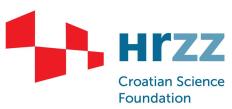Isolated People and Communities in Slovenia and Croatia
Principal Investigator at ZRC SAZU
Dan Podjed, PhD-
Original Title
Izolirani ljudje in skupnosti v Sloveniji in na Hrvaškem
Project Team
Miha Kozorog, PhD, Špela Ledinek Lozej, PhD, Tatiana Bajuk Senčar, PhD, Katarina Polajnar Horvat, PhD, Prof Rajko Muršič, PhD, OEKA FF, Univerza v Ljubljani, Assoc Prof Peter Simonič, PhD, OEKA FF, Univerza v Ljubljani, Lana Peternel, PhD, PI in Croatia, Institute for Social Research in Zagreb, Assist Prof Anđelina Svirčić Gotovac, PhD , Institute for Social Research in Zagreb, Filip Škiljan, PhD , Institute for Migration and Ethnic Studies, Assist Prof Hrvoje Čargonja, PhD, Department of Ethnology and Cultural Anthropology, Faculty of Humanities and Social Sciences, University of Zagreb, Assist Prof Lucija Mihaljević, PhD, Department of Communication, Catholic University of Croatia-
Project ID
J6-4610
-
Duration
1 October 2022–30 September 2025 -
SICRIS
SICRIS -
Financial Source
Slovenian Research Agency

Croatian Science Foundation

The Covid-19 pandemic has brought several relevant issues to the forefront, including physical and social isolation, which is the focus of this project. We will use an anthropological approach to explain what it means to be isolated. Through ethnographic studies in isolated social spaces and abandoned areas, we will show how isolation shapes the experiences of insularity and emptiness in urban and rural areas among individuals and communities in Slovenia and Croatia. We will also explore how different modalities of isolation shape experiences, values, and attitudes toward theenvironment and the future.
The main goal of our project is to understand what it means to be isolated at different times, places and situations in two countries, Slovenia and Croatia. Our specific objectives are to:
1. Identify and compare experiences of isolation. We ask how isolation occurs and persists among people and in small communities before and after a pandemic. To this end, we will identify the characteristics of isolated communities throughout history and examine when isolation becomes an opportunity.
2. Determine the different values and attitudes within and between isolated communities in different cultural, historical, and socio-political contexts. We will ask what advantages and disadvantages isolation has, might have in the future, or has had in the past. To this end, we will identify the importance of values, well-being, quality of life, and other conditions specific to different regions, historical backgrounds, and political systems.
3. Identify the types of isolation. What types of isolation exist in Slovenia and Croatia? What types of isolation have existed in the past and could exist in the future? By presenting the new theoretical and empirical findings obtained during the project, we will improve our understanding of the multi-faceted nature of isolation from different perspectives in different socio-political and economic contexts.
4. Develop recommendations for people- and community-centred development. In Slovenia and Croatia, we plan to develop new models for bottom-up policy solutions and combine them with existing practices acquired in isolated communities. The knowledge acquired in these projects will therefore create a new level of sensitivity to socially marginalized and excluded communities and individuals.
5. Dissemination of knowledge and findings. We will present the new knowledge gained through the project to researchers, practitioners, policy-makers, and the general public a) to promote understanding of the multi-faceted nature of isolation, b) to support the implementation of new mechanisms and policies to ensure the quality of life in isolation, and c) to prepare guidelines for reconnecting isolated communities and individuals.
The ethnographic sites in Slovenia and Croatia were selected for their geographic remoteness and historical, demographic, and socio-cultural characteristics. Each place is compared to a counterpart in a neighbouring country. Examples of social isolation include the Autonomous Factory of Ljubljana-Rog and the abandoned industrial area of Zagreb-Gredelj. Physical isolation is represented by the village of Drašiči and the island of Žirje. Selected remote areas are Goričko and Gorski Kotar, while Robidišče and Petrinja are two places struggling with the aftermath of the earthquake. An empty, disputed place that “connects” two countries across the border is Gorjanci (in Slovenian) / Žumberak (in Croatian).
The main scientific contribution of this project will be the conceptualization of memories, sensations and feelings related to the experience of isolation, remoteness and emptiness. Moreover, we will highlight not only the negative aspects of isolation, but also the innovative power that arises in remote places and isolated communities.
Phase 1: Preparations. Months 1–3: kick-off meeting; purchase of equipment; research review; methodology integration; project website. Months 4–6: establishing of communication channels in Slovenia and Croatia; equipment operation test; identification of key participants in the research (individuals, households, communities); preliminary field studies; archival research.
Phase 2: Research. Months 7–9: international preliminary research; establishing contacts in Slovenia and Croatia. Months 10–12: joint research in Slovenia and Croatia (initial research). Months 13–18: individual research in Slovenia and Croatia (ongoing research); publication of the special issue of Traditiones on historical aspects of isolation. Months 19–24: additional joint and individual research in Slovenia and Croatia (ongoing research).
Phase 3: Analysis. Months 25–33: final joint and individual research in situ; linking the results; cross-border discussions on first outcomes; publication of the special issue of Sociology & Space on contemporary aspects of isolation
Phase 4: Synthesis. Months 34–36: public presentation of project results; international symposium; publication of the edited volume Isolated People and Communities in Slovenia and Croatia; public exhibition on isolation in Slovenia and Croatia in ZRC SAZU’s Atrium.